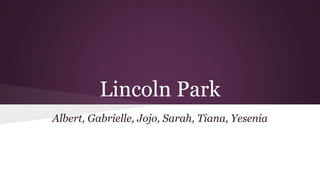Univ Connections with Community Lincoln Park
- 1. Lincoln Park Albert, Gabrielle, Jojo, Sarah, Tiana, Yesenia
- 3. History Most of the early inhabitants were German farmers who first named the area “Cabbage Patch”. In 1852, the Germans began building a Roman Catholic Church. Soon thereafter, the city of Chicago made a portion of the area into a cemetery for the church. Sadly, the graves proved such a health hazard that the cemetery was moved and the land became Lake Park in 1864. It was renamed Lincoln Park the next year for the assassinated president. This recreational center attracted such cultural institutions as the Chicago Academy of Sciences, the Lincoln Park Zoo, and the Chicago Historical Society.
- 4. Current Demographics â—Ź Median Household Income of Lincoln Park: $75,122 â—Ź Population: 65,377 â—Ź 23,146 people per square mile â—Ź Race Distribution: 86.38% Caucasian, 5.79% Asian, 4.30% African American, 0.25% Native American, 1.71% Mixed Race, 1.58% Other â—Ź Median age: 31.9 years of age
- 5. Landmarks - Abraham Lincoln Monument - Built in 1887 - Lincoln Park Zoo - 1868 first animal acquired - Biograph Theatre - Built in 1950
- 6. Our Activities and Reflections ● Visited DePaul University, many shops along Lincoln Avenue, St. Paul’s Church, and Lincoln Park. ● Personal Reflections
- 8. LINCOLN PARK
- 9. Works Cited "How Rich Is Your Neighborhood?" Crain's Chicago Business. Www.Chicagobusiness.com, 08 Jan. 2013. Web. 18 Oct. 2014. "Lincoln Park, Chicago, IL Demographics." Data & Community Statistics. AreaVibes, 2012. Web. 18 Oct. 2014. "Lincoln Park Neighborhood in Chicago, Illinois (IL), 60614 Detailed Profile."Lincoln Park Neighborhood in Chicago, Illinois (IL), 60614 Subdivision Profile. Www.City-Data.com, n.d. Web. 19 Oct. 2014. "Loyola University Chicago to Data=!3m1!4b1!4m14!4m13!1m5!1m1!1s0x880fd1a0d95c53a9:0x42b5c8e3d98f2dff!2m2!1d- 87.657866!2d41.99862!1m5!1m1!1s0x880fd319371400cd:0x7e41eb482114a7ae!2m2!1d-87.6513043!2d41.9214378!3e0 - Google Maps."Loyola University Chicago to Data=!3m1!4b1!4m14!4m13!1m5!1m1!1s0x880fd1a0d95c53a9:0x42b5c8e3d98f2dff!2m2!1d- 87.657866!2d41.99862!1m5!1m1!1s0x880fd319371400cd:0x7e41eb482114a7ae!2m2!1d-87.6513043!2d41.9214378!3e0 - Google Maps. N.p., n.d. Web. 20 Oct. 2014. “Lincoln Park” Encyclopedia of Chicago. Bennett, Larry. Fragments of Cities: The New American Downtowns and Neighborhoods. 1990. Ducey, Michael H. Sunday Morning: Aspects of Urban Ritual. 1977. Pacyga, Dominic A., and Ellen Skerrett. Chicago, City of Neighborhoods: Histories and Tours.1986., www.encyclopedia.chicagohistory.org, Web. 20 Oct. 2014.








